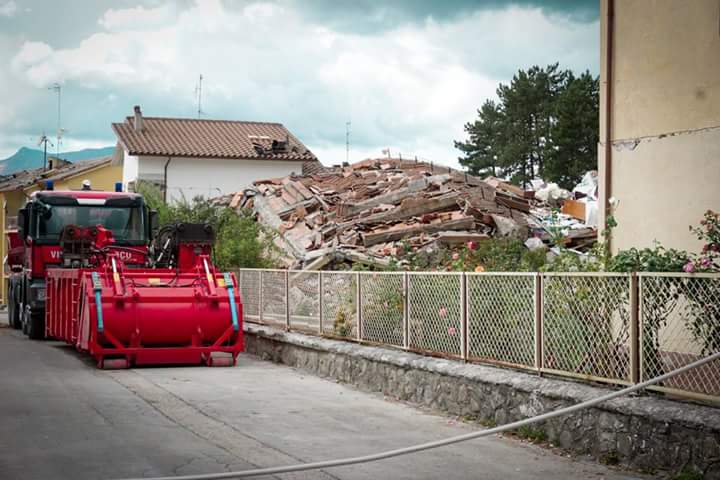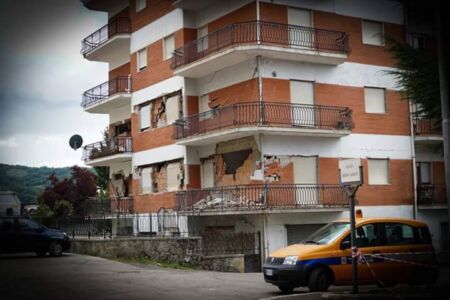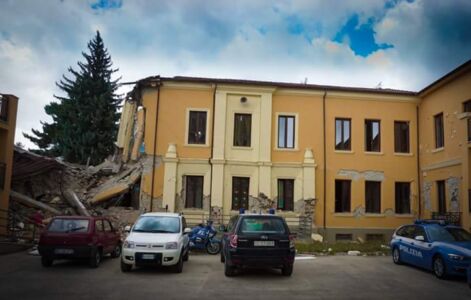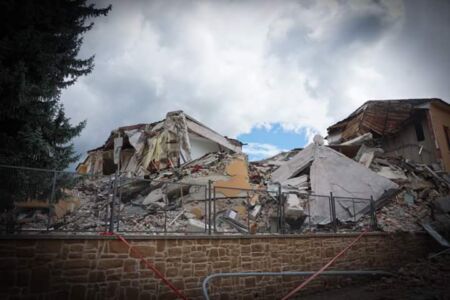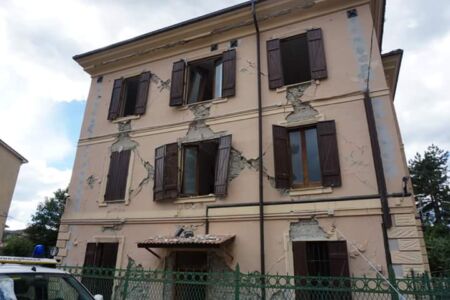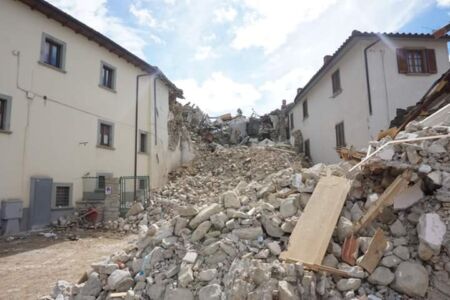Gli effetti del terremoto nella parole e immagini del nostro corrispondente che ha diretta conoscenza dei luoghi
Amatrice è un borgo dell’Alta Sabina, molto bello e curato, con una tradizione in molti settori. Diversi professionisti e imprenditori, nativi dei luoghi, si sono trasferiti per il lavoro a Rieti o a Roma rientrando ad Amatrice per i week end e mandando i figli dalle nonne in estate, come è successo il 24 agosto 2016. Di lì ad una settimana ci sarebbe stato il cinquantennale della festa della Pasta alla Amatriciana, il borgo era già affollato, per molti erano le uniche vacanze.
Silvio Tilesi si allena da anni con me in palestra in attività di gruppo a Rieti. La sua casa è quella con la freccia Hotel Roma, proprio nei pressi del famoso hotel dove ogni sabino e ogni turista si reca per mangiare le vera amatriciana, me compreso (il cuoco è ricoverato all’ospedale di Rieti molto grave). La sua casa è stata edificata totalmente in acciaio, con tamponamenti in mattoni, tetto in lamiera, eppure i segni del passaggio della scossa sono enormi. Purtroppo il vero dramma la notte è stata l’assenza di luce. Mi ha riferito di essersi svegliato e la prima sensazione è stata la polvere in bocca, ovunque; il buio rendeva tutto ancora più drammatico. Dopo la tragica scossa ha preso mamma e papà con il fratello per portarli fuori all’aperto ma il portale d’ingresso, che era l’unico a comprendere una trave zoppa che non scaricava a terra, risultava deformato e il portone bloccato. Con un calcinaccio il fratello ha letteralmente demolito la maniglia del portone, facendo uscire la famiglia. Sono andati nella piazza a fianco dell’abitazione, dove sono rimasti stretti tra loro cercando di farsi coraggio. Alle 7,00, finalmente, qualcuno è arrivato, purtroppo anche solo per vedere altri scavare e aiutare; di sciacallaggi ne esistono diversi, diciamocelo.
L’Hotel Roma è imploso. In un piano mancano i pilastri, sono diventati sabbia, ridotti in corpuscoli da cui spuntano poche staffe: poche come disposizione, esili in sezione. Certo, il tutto va riferito alla normativa vigente all’epoca ma fa riflettere. Una persona è morta sotto una casa che vede due perfette cerniere formatesi al tetto e alla base. Il tetto, pesante, è rimasto intero, compatto, surreale, in cemento con i suoi coppi ancora in posizione. Uno dei pilastri di sostegno, completamente scardinato sia alla testa che al punto di contatto con la fondazione, è posto orizzontalmente. I giunti non erano realizzati bene, si ricostruirà l’iter per capire. Anche per la scuola, s’indagherà per approfondire: sembra che l’intervento sia avvenuto solo a metà per quella disgraziata differenza che in materia sismica esiste tra adeguamento e miglioramento, soli 160.000 euro. L’inchiesta cerca già i suoi indagati fra il costruttore o magari il sindaco (eroe nazionale) e l’Ufficio Asl e Urbanistica (che vi assicuro essere girone dantesco per esperienza diretta).
Il terremoto ha colpito “a chiazze”, eppure si presuppone omogeneità dei suoli; allora a essere colpevole è il costruito. Edifici poco meno che lesionati stanno al fianco di palazzine rase al suolo. L’operato dell’uomo è in discussione, così come le leggi con cui lo si attua. La nostra edilizia, il tessuto millenario (Amatrice è un borgo antico), tutto va ridiscusso cercando anche le connessioni con l’attuale crisi economica e produttiva italiana. Non possiamo accontentarci del “com’era dov’era”: vuol dire non pensare, non progettare il futuro e la sostenibilità.
Come ci dobbiamo muovere, anche a fronte dell’inflazione delle professioni che impoverisce la qualità dei tecnici e della nebulosità dei regolamenti, tanti, poco leggibili, a volte alternativi all’Europa e non altrettanto efficaci? Inutile cercare risposte negli uffici pubblici e negli apparati statali come la magistratura o il governo.
Inflazione. Oramai anche di terremoti; e di morti, 291. Per un’ironia della storia, quasi come all’Aquila, ma in un’area molto più raccolta.
VERSIONE INGLESE
The effects of the earthquake in words and images of our correspondent who knows those places
Amatrice is a village of the upper Sabina, very nice and well-kept, with a tradition in many sectors. Several professionals and entrepreneurs, natives to the places, moved for work to Rieti or Rome returning to Amatrice for the weekend and sending the children by their grandmothers in summer: this happened on 24 August 2016 too. Since then in a week, there would have been fifty years of the feast of “the Amatriciana pasta” and the village, of course, was already crowded, for a lot of people who were there on holiday.
Silvio Tilesi has trained for years with me in the gym in Rieti. His house is the one with the arrow “Hotel Rome”, just near the famous hotel where every people from Sabina area and every tourist goes to eat the true “Amatriciana pasta”, including me (the chef is now at the hospital of Rieti in very serious conditions of life). His house was built entirely in steel, with plugging in bricks and roof in sheet metal, yet the signs of the passage of the shock are enormous. Unfortunately the true drama during the night was the absence of light. He told me that he woke up early and his first impression was the dust at his mouth and everywhere: the darkness made everything even more dramatic. After the tragic shock (tremor), he and his brother took their parents to safety: they were successful to pull them outside simply demolishing the handle of the door because the entrance portal, which was the only one to take a beam lame that did not flush to the ground, was deformed and the door was locked: by a flake of plaster, his brother literally broke the handle off the door, and so they were finally safe. They went to the square next to the house, where they stayed there up to next morning. At 7,00 am, finally, someone arrived even unfortunately only to see others dig and help too: looting of different forms exists, let’s be said.
The Hotel Roma collapsed. In a level, the pillars are missing: they have become sand, reduced in small particles from which a few brackets are visible: they are few as they should be like arrangement, slender in section. Of course, this must be reported to the legislation in force at that period but it is time for you to look again. A person died under a house which sees two perfect hinges formed to the roof and to the base. The heavy roof remained integer, compact, surreal, in cement with its roof tiles still in position. One of the pillars completely unhinged (pulled off) both at the head and at the point of contact with the foundation, is horizontally placed. The joints were not made very well and then a legal procedure will be performed in order to understand. Also for the structure of the school, they will investigate: it seems that the intervention has been made only a half of that “unfortunate” difference which, according to seismic matters, exists between adaptation and improvement: only 160,000 euro were spent for it. The investigation is on its suspects on the builder and on, maybe , the mayor (The National Hero you see) or on the Local Health Board with the administrative and urbanism offices too: it is as you were in “Dante’s circles”.
The earthquake patchy struck and nevertheless you might assume homogeneity of soils; so what was built is to be guilty? Damaged buildings are alongside destroyed buildings. The work of man is in question as well as the laws which it is implemented by. Our construction, the millennial fabric (Amatrice is an ancient village) and everything have to be reconsidered looking for connections with the current economic Italian crisis too. We cannot be satisfied by “what and where it was like”: it means not to think and not to design the future and sustainability of our places.
How we should proceed, even in the face of the inflation of the professions that deprives the quality of technicians and of the fog of procedures? These ones are so many and not so very comprehensible and sometimes different in Europe and not equally effective. It is useless to seek answers in municipal or national bureaus as in those ones of the courts or of the government department.
Inflation: it is now even for earthquakes; and the dead: 291 people died. For irony of history, almost as in Aquila earthquake with only a difference: Amatrice is in a little area.
About Author
Tag
terremoto , territorio fragile
Last modified: 12 Ottobre 2016


